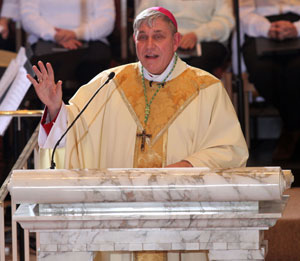
MILWAUKEE – Combining reflection on Jn 21:15-19 with a delineation of church teaching on the duties of the bishop, Archbishop Jerome E. Listecki preached his first homily as Milwaukee’s 11th archbishop during his Mass of Installation, Monday, Jan. 4.
The archbishop told those attending the by invitation-only event at the Cathedral of St. John the Evangelist and those watching on TV and online that Jesus “actually speaks through Peter to all of us.”
“It is as if we are standing with Peter and Jesus is asking us, do you love me more than these?” the archbishop said.
The archbishop noted that governance in the church is not a solitary venture, but a collaborative effort.
“Our strength as a church comes from our union with our universal shepherd, Benedict XVI. In professing our union with the Holy Father we make it clear that this unity is a reflection of our desire to follow Christ in his church,” he said.
Archbishop Listecki added that his being a link between the local church and the universal church serves another purpose.
“In our own American society, we must present a clear alternative to the established secular religion which permeates our daily lives,” he said. “We need to acknowledge mystery and our dependency upon God. It is in our faithfulness in reflecting the mind and the heart of our church that represents the singular voice of Christ to our community and the world.”
Regarding his role as teacher, Archbishop Listecki said it was his job “to form and inform the faithful in their relationship to Christ and his church.”
“In the teaching role of the bishop, the task is literally to come and to know the subject Jesus himself, so that he, the Christ, may be taken into our lives,” he said.
Acknowledging that adherence to church teaching can be difficult, the archbishop emphasized the need to “sacrifice for the truth” in order to demonstrate one’s love.
|
Six welcome celebrations set
The installation of Archbishop Jerome E. Listecki as archbishop of Milwaukee will include a series of six regional celebrations of welcome beginning Thursday, Jan. 7 at St. William Parish, 440 N. Moreland Blvd., Waukesha, at 7 p.m. |
Archbishop Listecki said, “It is interesting to note that John Paul II was applauded by the Western societies when he critiqued the Godless communism of the East for their lack of individual rights and freedoms, yet those very same Western societies turned a deaf ear to his warnings of the destructiveness of radical individualism, consumerism, materialism and relativism.”
As for his role as sanctifier, the archbishop noted the connection between that office and the “common vocation to holiness.”
“In the very beginnings of the church in the Acts of the Apostles we read of the disciples devoting themselves to the teachings of the apostles and to the communal life, the breaking of the bread and to the prayers” he said. “The symbol of the cross is no longer a sign of death but has been transformed to represent hope. The cross now declares just how great our God’s love is for us that he did not even spare his only Son for our sake.”
Archbishop Listecki continued, “Do you love me? In governing, teaching and sanctifying together we will answer that question with lives placed at the service of his church.”
The archbishop noted that three of his predecessors as archbishop of Milwaukee had formed him – Archbishop Michael Heiss, also the first bishop of La Crosse, “established the Catholic identity for the region of central Wisconsin; Cardinal Samuel Stritch whose “gentleness and charity was held as a model for all”; and Cardinal Albert Meyer “whose American leadership at the Second Vatican Council was legendary.”
Citing the work of clergy, religious, lay ecclesial ministers and the lay faithful as “the faithful who allow the Lord to use them as instruments of his presence,” Archbishop Listecki said he looked forward to “building on the traditions of the past, witnessing to the present and placing our confidence in him, who is the hope for our future.”
Earlier, Archbishop Pietro Sambi, Apostolic Nuncio to the United States, read Pope Benedict XVI’s Nov. 14, 2009 letter appointing Archbishop Listecki to Milwaukee.
In the letter, the pope noted the archbishop’s regional roots.
“For it was first in the City of Chicago that you skillfully made use of the means of social communication to proclaim the Gospel far and wide; and then, for the flock of La Crosse, you carried out your responsibilities with constant zeal, prudent judgment, and much knowledge…”
Acknowledging that he had given “due consideration to the recommendation of the Congregation for Bishops,” Pope Benedict wrote, “We judge you to be suitable to govern this metropolitan see.”
The Holy Father commended Archbishop Listecki “to the intercession of St. John the Evangelist, patron of your archdiocese, through whose example you may entrust to your beloved people the superabundant riches of the Gospel, so that, to the greatest extent possible, they may grow in the virtues of faith, hope and charity.”
